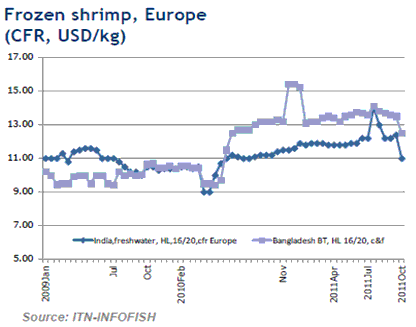Shrimp - December 2011
.jpg)
The shrimp market is on the rise despite the difficult global economic situation.
During the first half of 2011 the global shrimp market remained positive despite lower supply and strong prices worldwide. In Japan, demand for processed shrimp has been higher after the earthquake and tsunami, while demand for raw frozen shrimp dipped. Processed shrimp imports were also higher in other markets such as the EU and USA, confirming the positive trend for value added-shrimp.
In Thailand, the seasonal harvest of vannamei has been delayed as result of the severe floods, while in Viet Nam’s Mekong delta black tiger production was almost wiped out by disease leading to a shortage of raw material and pushing prices up.
India also increased vannamei aquaculture significantly in the southern areas, with a consequent decline in black tiger shrimp production. The wild caught Karikadi and poovalaan shrimp season was disappointing and packers faced difficulties in meeting agreed commitments.
In Japan, the post-tsunami shrimp market started to recover in June and the trend persisted into July and August. Sales of processed and semi processed shrimp increased but raw shell-on shrimp sales declined. Imports of raw frozen shrimp fell during the period January-July 2011 but increased by 8% for processed shrimp.

The Asian shrimp producing countries are facing a number of different challenges. After the severe flooding in Thailand and the typhoon that hit Viet Nam, as well as the disappointing landings of small wild shrimp from India, the shrimp supply chain will be affected in the near future. Given this scenario, prices are expected to remain firm. The Thai shrimp industry revised down this year’s export growth forecast to 5% (from an earlier estimation of 8%).
China’s exports increased this year by nearly 20% during the January-June period compared with the same period in 2010. Imports of all types of shrimp increased to 178 704 tonnes against 149 760 tonnes in 2010.
In the USA, domestic producers are having difficulties in selling their products as imported supplies of shell-on shrimp improved as well as increased availability of shrimp production from Ecuador. In the period January to July, overall US imports increased by 2.1% compared with the same period of 2010.

Thailand continued to be the main supplier followed by Ecuador and Indonesia. Total domestic landings from January-August increased by 65.7% compared with the same period of 2010, but were still below the high of 2009. Economic conditions are limiting further improvement in demand.
In Mexico,farmers decided to harvest early because of concerns over white spot disease. This could cause a decline in the availability of popular larger sizes.

In Europe, trading activities slowed down in the second quarter of the year, while demand remained strong in other major markets such as the USA. Despite the crisis in the Eurozone, shrimp imports into the EU increased during the first half of 2011 and totalled 386 000 tonnes. Import volumes of raw frozen shrimp increased also by 10% during this period, with Ecuador, India, Greenland, Argentina and China being the main suppliers of this category. Demand from major EU countries remained strong with the exception of France where a decrease of 7.5% was seen. Imports by Spain, UK, Italy and Germany grew by 33.5%, 31.6%, 7.8% and 4.6% respectively during the January to June period.
Retailers are procuring products for the December/January sales increasing the seasonal demand for shrimp. The market is still price sensitive, which will favour sales of vannamei and other shrimp species that are in the lower priced categories.

